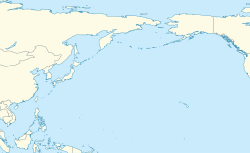Korean War
The base was originally established during the Korean War as Suwon (K-13) Air Base and hosted United States Air Force units. [2]
The base was evacuated on the night of 30 June 1950 in the face of the Korean People's Army (KPA) attack, but the base was not occupied by the KPA until 2 July 1950. [3] : 34
The base was recaptured on 24 September 1950 following the Inchon landings. [3] : 161 The 811th Engineer Aviation Battalion arrived at the base on 1 October to repair the airfield and laid down PSP over the runway. [3] : 179
The base was evacuated in the face of the Chinese Third Phase Campaign on 5 January 1951 and the base's buildings were destroyed. [3] : 279 The base was recaptured on 28 January as part of Operation Thunderbolt [3] : 293 and by 6 March, despite its poor condition, the base was used for the staging of F-86 patrols along the Yalu River and Mig Alley. [3] : 295
USAF units based at Suwon included:
On 17 June 1951, at 01:10 hours, Suwon was bombed by two Korean People's Air Force Polikarpov Po-2s. Each biplane dropped a pair of fragmentation bombs. Two bombs burst on the flight line of the 335th Fighter Squadron. One F-86A, AF Ser. No. 49-1334 was struck on the wing and began burning; the fire took hold, gutting the aircraft. Eight other Sabres were also damaged in the attack. [4]
On 22 December 1952, a Hellenic Air Force C-47D, Ser. No. 49-2612 was taxiing at Suwon Air Base when it was hit by USAF F-80, AF Ser. No. 49-0722, that was taking off, killing all 13 on board the C-47. [5]
Accidents and incidents
On October 10, 1984, a corporately owned Northrop F-20 Tigershark, AF Ser. No. 82-0062, c/n GG1001, FAA registration N4416T, on a world sales tour, crashed at Suwon, killing Northrop chief test pilot Darrell Cornell. During the last maneuver of the final demonstration flight, the aircraft stalled at the top of an erratic vertical climb and dove into the ground from 1,800 feet (550 m). [6] [7]
On May 23, 1996, Korean People's Air Force Captain Lee Chul-Su defected in a Shenyang J-6 (#529), landing at Suwon. [8]
On May 5, 2006 Captain Kim Do-hyun of the ROKAF's Black Eagles display team was killed when he lost control of his A-37B Dragonfly during an air show. [9]
On January 11, 2022, Major Shim Jeong-min from ROKAF's 10th Fighter Wing was killed due to an engine fire in his KF-5E during training. He stayed in the jet to avoid crashing into a nearby village.




